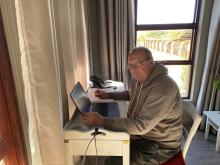Suddenly risk management professionals’ voices are being heard. The professional services that they provide are being heeded and the recommendations being taken with the seriousness it has always deserved but was seldom afforded.
This is according to Nico Pienaar of South African surface mining industry association Aspasa, who adds that the pandemic has elevated the need for basic hygiene, disease identification, emergency response readiness, training and many other aspects to the level where it can effectively mitigate many of the risks of transmission of the disease.
“What we are experiencing right now is the application of pure, unadulterated H&S principles in response to the perceived threat. Only this time, it has the buy-in of everyone, and the required response has been legislated, well communicated and appropriate to deal with the spread of the disease as best we can.
“This is not usually the case, and even the most serious threats to the wellbeing of people in the mining industry has been largely ignored or dealt with by providing personal protective equipment (PPE). Why do we not see nearly the same response to HIV Aids, diabetes, heart disease, silicosis, alcoholism, road safety or violent crimes in the workplace.
“Are these causes of death less significant than Covid-19 deaths? Are lower death tolls for some of these inflictions more acceptable? The answer is a resounding no. Even one death is one too many, and Aspasa wants to encourage the industry and all our members to continuously assess all risks in the workplace. In addition, we must seek similarly effective strategies to deals with and mitigate these threats,” says Pienaar.
He continues that the pandemic has rightly turned safety into an educated, intelligent, humanising and people-centric practice. “What we have seen during this pandemic has been the assessment of the situation, modelling of possible outcomes and the adoption of a risk-related plan that is designed to deal with all aspects of the disease in the workplace. Rather than focusing on one or two core areas, such as the application of PPE or policing of people on site, the current H&S response is all-encompassing and has the flexibility to change every day as required.
“Perhaps the current model can be adapted and applied to all spheres of our lives, from the legislation of appropriate responses, to the assessment of the situation on the ground and risk assessment, to the management of risks and a combined and effective response.
“This is the type of response that can help us to overcome more sicknesses in the workplace, prevent injuries and stamp out other risks that affect our safe and expedient careers in the mining industry,” concludes Pienaar.






